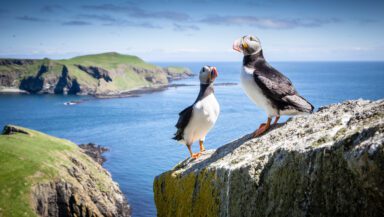The Marine Conservation Zone, named Offshore Overfalls [1], covers 594 km2 and was designated in January 2016. It was established to protect the sandy seabed in the area. This provides an important habitat for various species, including an undulated ray which is classed as ‘endangered’ on the IUCN threatened species list [2].
According to the JNCC website, no specific management measures have been implemented since the area was designated [3]. This means various types of fishing effort, including the trawling method employed by the Margiris and other industrial trawlers, are permitted.
Chris Thorne, an Oceans Campaigner at Greenpeace UK, said:
“This highlights the UK government’s laissez-faire attitude towards ocean protection, and its continued preference for paper parks that are little more than lines on a map, failing to properly protect Britain’s spectacular marine life.
“Just 7 km2 of UK waters are fully protected marine areas, the most effective tool for ocean protection and increasing resilience to climate change. Our government speaks well about ocean protection, but these are empty words until it takes serious action to replace the broken network of paper parks, which allow supertrawlers like Margiris to fish in supposedly protected areas right on our doorstep.”
The Margiris spent significant time fishing in the Offshore Overfalls Marine Conservation Zone, as shown by Marine Traffic data collected by Greenpeace [map tracking images available upon request]. This is permitted under the Marine Conservation Zone’s management plan, which commits to ensuring the “subtidal coarse sediments, subtidal mixed sediments, subtidal sand” marine habitats “remain in a favorable condition” [4]. However, no specific management measures have been put in place since it was designated in 2016.
The Margiris is capable of processing 250 tonnes of fish each day, and can carry 6,000 tonnes. Its owners stated the ship was in the Channel to catch mackerel and pilchards. While fishing in the Channel, its average catch per day was 68 tonnes of Mackerel and 2 tonnes of Pilchards. This means the Margiris caught a total of 1,610 tonnes of fish in UK waters.
The owners claimed there was zero bycatch. This claim has been challenged by local fishermen, politicians and conservation groups, who have expressed serious concerns about how a ship of this size can operate sustainably in UK waters.
Fully protected marine areas are the most effective tool for ocean protection [5], because the elimination of extractive or damaging activities protects the entire ecosystem, from surface to seabed. However, currently just 7km2 of UK waters are fully protected. Scientists have called for 30% of the world’s oceans to be fully protected by 2030 [6]. This is the minimum required to allow fish stocks to recover. The remainder would need to be sustainably managed, including reviews on permitted vessel sizes and gear types.
Ends.
Photo/video – images and video of the Margiris fishing in the English Channel from [insert date] are available here
Contact:
Greenpeace UK Press Office – press.uk@greenpeace.org or 020 7865 8255
James Hanson, Press Officer – Greenpeace UK – james.hanson@greenpeace.org – 07801 212 994
Notes:
[1] https://www.gov.uk/government/publications/marine-conservation-zones-offshore-overfalls
[2] https://www.sussex-ifca.gov.uk/offshore-overfall-mcz
[3] The Offshore Overfalls Marine Conservation Zone is currently “processing towards being well managed”, according to the Joint Nature Conservation Committee. This means it is “unlikely to be moving towards its conservation objectives”. The latest update also states that “progress is ongoing with regards to the recommendation of a fisheries management proposal to the European Commission.” http://archive.jncc.gov.uk/default.aspx?page=6776
[4] http://www.legislation.gov.uk/ukmo/2016/16/pdfs/ukmo_20160016_en.pdf
[5] Fully protected marine areas are agreed to be the most effective tool for ocean protection. For example, a meta-analysis of scientific studies showed that the biomass of fish assemblages is, on average, 670% greater within ocean sanctuaries (i.e. fully protected areas) than in unprotected areas, and 343% greater than in partially-protected MPAs. Fish biomass is a powerful metric to use in assessing MPA success because it provides a strong indicator of the health of fish assemblages and thus ecosystem health., The elimination of extractive and damaging activities protects marine life from the sea surface to the seabed, preserving important ecological and biogeochemical links, ensuring the protection of the whole ecosystem and the safeguarding of related ecosystem processes.
[6] Scientists calling for 30×30 protection is in Greenpeace report 30×30: A Blueprint for Ocean Protection, available here: https://www.greenpeace.org/international/publication/21604/30×30-a-blueprint-for-ocean-protection/



